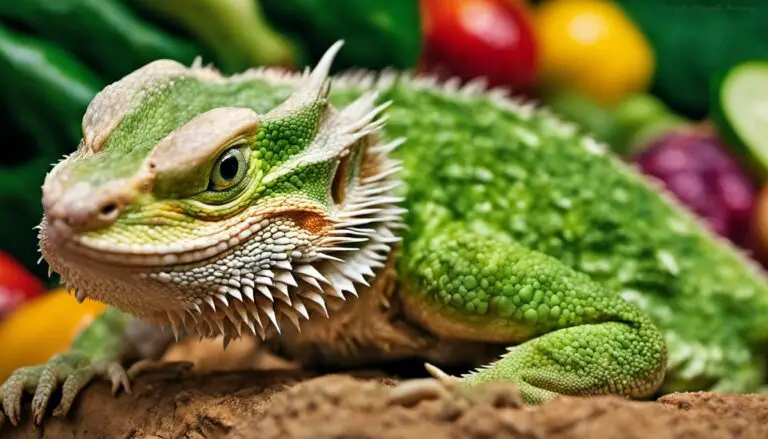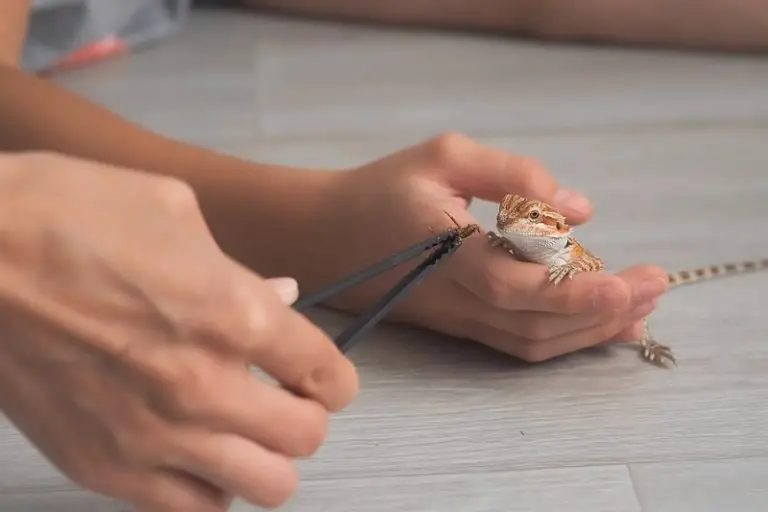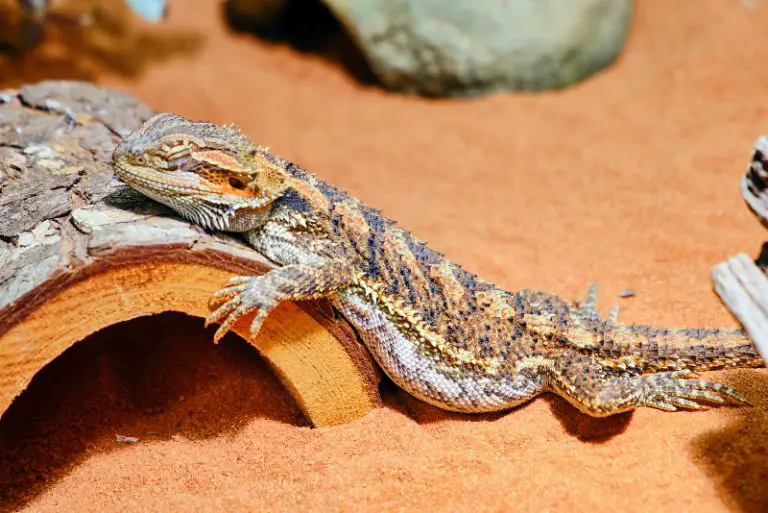Fancy Bearded Dragon: A Comprehensive Care Guide

Are you considering welcoming a Fancy Bearded Dragon into your home? These unique and engaging creatures make wonderful pets, but it’s essential to understand their specific needs and requirements. In this comprehensive fancy bearded dragon care guide, we will cover everything from understanding their origin and characteristics to creating the perfect habitat, nutrition, behavior, health concerns, and more.

Get ready to embark on a fascinating journey into the world of Fancy Bearded Dragons!
Contents
Table of Contents
Short Summary
Fancy Bearded Dragons are an intriguing reptile species native to Australia, with captivating morphs, colors, and behaviors.
Creating an ideal habitat involves providing the appropriate enclosure size, proper heating and lighting, enrichment, and decor to promote health & well-being.
Responsible ownership involves providing a nutritious diet, understanding their personality, regular vet visits & engaging with your dragon for a positive pet experience.
Understanding Fancy Bearded Dragons
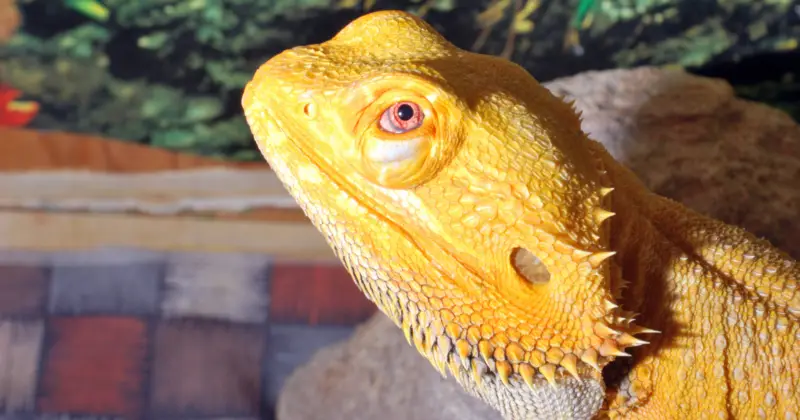
Fancy Bearded Dragons are a captivating type of Bearded Dragon, distinguished by their varying morphs and colors, lateral spines extending from the sides to the base of their tail, and a “beard” that can be distended as a defense mechanism.
Also known as the inland bearded dragon, these reptiles are native to Australia’s forested, semi-desert environments. Young bearded dragons inherit these fascinating traits from their parents, making them equally captivating pets.
They exhibit semi-arboreal behavior, often found on branches or on the ground, and display unique behaviors such as head-bobbing and circumduction, a pattern of turning their legs in circles.
Morphs and Colors
Fancy Bearded Dragons are available in various colors and morphs, including brown, orange, red, silute pigmentation, and yellow. They possess various genetic traits impacting their color and pattern, including recessive, dominant, and polygenic genes.
Female bearded dragons lay up to three clutches of eggs. Each clutch can contain up to 35 eggs. Proper nutrition is essential during this time, and it is advised to remove the eggs from the nest box and place them in an incubator. This ensures the right bearded dragon food is provided for the mother and hatchlings’ health.
Origin and Popularity
Fancy bearded dragons originate from Australia and have become popular pet bearded dragons due to their unique appearance and friendly nature. The Central Bearded Dragon (Pogona vitticeps) is the most widely kept among the six species, is known for its friendliness and low-maintenance care requirements, making it an ideal choice for those looking for an adult bearded dragon as a pet.
Three primary factors contribute to their popularity among reptile owners: their unique appearance, friendly nature, and the fact that bearded dragons love interacting with their owners.
Creating an Ideal Habitat for Fancy Bearded Dragons

Creating a suitable bearded dragon habitat for your Fancy Bearded Dragon is crucial to ensure their health and happiness. You can raise healthy bearded dragons by providing the right enclosure size and design, proper heating and lighting, and an engaging environment with enrichment and decor. Following a bearded dragon care guide can help you achieve this goal.
A well-maintained habitat helps prevent health issues and allows your dragon to thrive.
Enclosure Size and Design
The ideal enclosure size for a Fancy Bearded Dragon depends on its age and size. A 25-gallon tank is suitable for a young bearded dragon, but an upgrade to a 40-gallon tank is recommended once the dragon reaches 6 inches in length, usually around 4 months of age. A terrarium of at least 40 gallons (151 L) in volume with a screened lid is suggested for adult bearded dragons.
When setting up the enclosure, consider using suitable bearded dragon substrate options such as tile, newspaper, indoor/outdoor carpeting, and reptile carpet while avoiding sand, fine gravel, wood chips, or crushed walnut shells that could be accidentally ingested.
Include rocks and branches to replicate their natural environment, and avoid electrically heated rocks to prevent burns. Basking rocks and branches placed under the heat lamp also serve as appropriate hides for bearded dragons.
Heating and Lighting
Proper heating and lighting are essential for your Fancy Bearded Dragon’s health and well-being. Daytime temperatures should generally be between 80–88 degrees Fahrenheit. A basking spot should ideally range from 95–105 degrees. Nighttime temperatures can be quite cool.
They can drop all the way down to 70 degrees. To achieve this temperature gradient, you can use a combination of heat lamps, ceramic heat emitters, and under-tank heating pads.
It’s also crucial to provide your dragon 12-14 hours of UVA/UVB light daily. UVA produces heat and establishes the day/night cycle, while UVB supplies essential vitamin D3 for calcium absorption. Ensure you have a high-quality UVB lamp that adequately exposes your dragon.
In addition to proper heating and lighting, maintaining the ideal humidity range of 40-60% is vital for your Fancy Bearded Dragon’s health. Regularly monitor the humidity levels in the enclosure using a hygrometer and make adjustments as necessary, such as misting the enclosure or using a humidifier.
Enrichment and Decor
Creating an engaging and comfortable environment within the enclosure is essential for your Fancy Bearded Dragon’s well-being. Add climbing structures like branches and rocks to simulate their natural habitat and encourage exercise. Provide hiding spots such as caves or cork bark for your dragon to retreat to when they feel stressed or need to rest.
It’s important to maintain a clean and sanitary environment for your dragon. Spot-clean the enclosure daily and thoroughly clean bi-weekly, using a mild soap and water solution. Replace substrates like reptile carpets as needed to prevent bacteria, odors, and debris. Always make sure to thoroughly wash your hands after handling your dragon to reduce the risk of salmonella transmission.
Nutrition and Feeding Guidelines
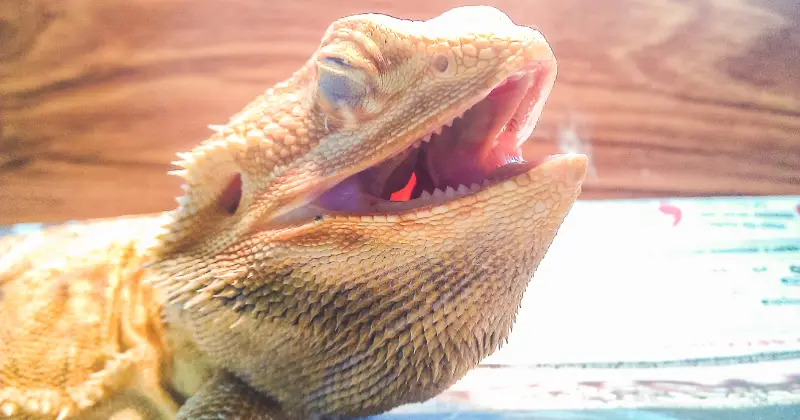
A balanced diet is crucial for your Fancy Bearded Dragon’s health. As omnivores, beardies consume various insects, vegetables, and fruits, so understanding what a bearded dragon eats is essential. Ensuring they receive the right nutrients and follow proper feeding schedules will keep your dragon healthy and happy.
It is important to provide a variety of food items to ensure your dragon gets the nutrients it needs.
Omnivorous Diet
Fancy Bearded Dragons consume various foods, and it’s important to know what bearded dragons eat to ensure a healthy diet. Insects like crickets, dubia roaches, mealworms, phoenix worms, and hornworms should be included in their diet.
This will provide essential nutrients to their body for healthy living. In addition to insects, provide a mix of vegetables and fruits, with dark, leafy greens like romaine, dandelion greens, turnip greens, mustard greens, beet greens, collard greens, bok choy, Swiss chard, and escarole being ideal choices.
It’s essential to provide a balanced diet for your dragon. A full-grown bearded dragon’s diet should contain 90% plant matter, including bearded dragon pellet food and 10% insects. Vegetables should be an integral part of your beardie’s diet, comprising around 20%. Carrots, squash, zucchini, peas, and broccoli are some of the most nutritious vegetables we can include in our diets.
Feeding Frequency and Portion Sizes
The frequency and portion sizes of your Fancy Bearded Dragon’s meals depend on their age and size. Baby and juvenile bearded dragons should be fed insects 2-3 times daily. Each meal should include 2-3 small insects. Bearded dragons need an appropriate amount of insects in their diet. Adult bearded dragons should be fed 3-4 times a week, with about 4-5 insects per serving.
When feeding your dragon, it’s important to avoid overfeeding and providing too much food. The food should be smaller than the distance between their eyes.
Keep a shallow water bowl with clean water at all times, even though many bearded dragons may obtain the necessary hydration from their diet and may not drink from bowls.
Supplements and Gut Loading
Fancy Bearded Dragons require supplemental calcium, vitamins, minerals, and trace elements for optimal health. Calcium is essential for sustaining healthy bones, muscle, and nerve function, while vitamin D3 is critical for calcium absorption. A quality multivitamin is also recommended to provide additional essential vitamins and minerals.
Gut-loading insects is another crucial aspect of your dragon’s nutrition. This involves providing the insects with a nutritious diet for 24-48 hours before feeding them to your dragon. By ensuring insects are adequately gut-loaded, your dragon receives the necessary nutrients from the insects they consume, and it lessens the potential of parasites and other illnesses that can be transmitted from the insects to your dragon.
Bearded Dragon Care Made Simple!
Fancy Bearded Dragon Behavior and Socialization
Understanding your Fancy Bearded Dragon’s behavior and socialization needs is essential for building a strong bond and ensuring their well-being. Fancy Bearded Dragons are typically docile and can be handled carefully, displaying curiosity and activity as they investigate their environment.
However, they may also exhibit territorial behavior, especially males, which is important to consider when housing multiple dragons together.
Territoriality and Cohabitation
Fancy Bearded Dragons, particularly males, demonstrate territorial behavior. It is not recommended to house bearded dragons together in captivity due to their potential to form a social hierarchy and become aggressive. Housing male bearded dragons together is especially discouraged.
As solitary creatures, providing each Fancy Bearded Dragon with its own enclosure is important to prevent territorial disputes and ensure a stress-free environment. However, you can still enjoy watching and interacting with your dragon individually, building trust and a strong bond over time.
Handling and Bonding
Handling your Fancy Bearded Dragon with care and patience is essential for building trust and facilitating bonding. When picking them up, carefully slide your hand under their belly and support their chin if they are a baby. Start slowly, holding them for only a few minutes each day and gradually increasing the duration if they appear comfortable.
Always wash your hands after handling your dragon. Reptiles may carry salmonella bacteria which can cause illness, so it is important to keep good hygiene. You’ll establish a strong bond and enjoy a rewarding relationship with your Fancy Bearded Dragon by consistently handling your dragon and providing a safe, comfortable environment.
Health Concerns and Preventative Measures

Awareness of potential health issues specific to Fancy Bearded Dragons and taking preventative measures is crucial for their well-being. Some common health concerns include metabolic bone disease, vitamin deficiencies, hypervitaminosis, sand or dirt impactions, wasting disease or atadenovirus, dehydration, protozoa or parasites, egg binding or dystocia, and mouth rot or stomatitis.
Early detection of these health issues can help ensure your dragon’s happy and healthy life.
Metabolic Bone Disease
Metabolic bone disease is a common health issue in Fancy Bearded Dragons, caused by insufficient calcium and vitamin D3 in their diet, resulting in weakened bones and other associated health issues. The underlying causes of this disease include inadequate calcium and vitamin D3 intake in their diet.
To prevent metabolic bone disease, providing a balanced diet with adequate amounts of calcium and vitamin D3 and opportunities for physical activity is essential. Ensuring proper heating and lighting, including UVB exposure, is also crucial for your dragon’s health.
Common Infections and Parasites
Fancy Bearded Dragons may experience various infections and parasites, such as respiratory infections, roundworms, hookworms, coccidia, gnats, ticks, and Isospora amphiboluri, a species of coccidia. Treatment options for these infections and parasites depend on the specific type and may include antibiotics, antiparasitic medications, and supportive care such as fluids and nutrition.
To reduce the risk of infections and parasites, establish a clean and sanitary environment, avoid contact with wild animals, and regularly clean and disinfect the enclosure. A balanced diet and proper nutrition can also help minimize the risk of infections and parasites.
Choosing a Fancy Bearded Dragon

Selecting a healthy, Fancy Bearded Dragon is the first step in ensuring a rewarding pet ownership experience. Whether you’re looking for a baby dragon or an adult beardie, choosing a reputable source, such as breeders, pet stores, and rescue organizations is important. This will help you find a healthy dragon with a suitable temperament for your home.
When selecting a Fancy Bearded Dragon, looking for signs of good behavior is important.
Evaluating Health and Temperament
When assessing a potential Fancy Bearded Dragon, evaluate their physical health by observing plump fat pads, clear and bright eyes, appropriate body weight, alertness, and a clean vent area. Also, monitor their temperament for any signs of aggression, fear, or stress.
Assessing for signs of dehydration, such as sunken eyes, wrinkled skin, and dry mouth, as well as potential infections, like bumps, lesions, sores, and discoloration, will help you choose a healthy dragon. Taking the time to evaluate the health and temperament of your new pet will ensure a positive and fulfilling relationship.
Responsible Ownership
Being a responsible owner of a Fancy Bearded Dragon is crucial for their well-being. This involves providing an appropriate habitat, supplying a nutritious diet, keeping the tank clean, and engaging with the dragon. It’s also essential to understand the dragon’s personality and to observe for any indications of illness or injury. Refer to a reliable bearded dragon care sheet to ensure you meet all their needs.
In addition to meeting their physical needs, responsible ownership also includes regular vet visits to monitor their care and maintain their health. By understanding and committing to the responsibilities of owning a Fancy Bearded Dragon, you’ll ensure their health and happiness for years to come.
Summary

In conclusion, owning a Fancy Bearded Dragon can be a rewarding and enriching experience if you’re willing to invest the time and effort to provide proper care. You’ll enjoy a long-lasting bond with your fascinating new pet by understanding their unique characteristics, creating an ideal habitat, providing a balanced diet, monitoring their behavior and socialization, addressing health concerns, and practicing responsible ownership.
Frequently Asked Questions
Are fancy bearded dragons hard to take care of?
Bearded dragons are fairly easy to care for as they have simple nutritional and environmental needs. With the correct lighting, temperature, supplements, and diet, they require minimal veterinary care, and their nails may need trimming every few weeks. They make great companions for beginner reptile owners.
What do fancy bearded dragons need?
Fancy bearded dragons need proper lighting, heating, and humidity in their tank to stay healthy and comfortable.
How big do fancy bearded dragons get?
Fancy bearded dragons typically reach an average size of 18 inches for males and 16 inches for females, while regular bearded dragons typically measure between 16-24 inches in length. This size difference is important to consider when selecting a bearded dragon as a pet. It is important to research the size of the species you are interested in and ensure you have the space to accommodate it.
Can you hold a fancy bearded dragon?
Yes, you can hold a fancy bearded dragon for as long as it will tolerate being held. Start with 15 minutes once daily and gradually increase the time, but don’t over-handle your dragon as it could lead to stress-related health problems. Some dragons even show signs of affection when handled.
What do I need to know about keeping a bearded dragon?
Keeping a bearded dragon requires having a vivarium with a hot and cool end, providing them with a UVB light and infrared lamp, feeding them a mixed diet of insects and leafy vegetables, and exposing them to a 12-hour photoperiod. Additionally, they should be handled and enriched during the day when their lights are on.

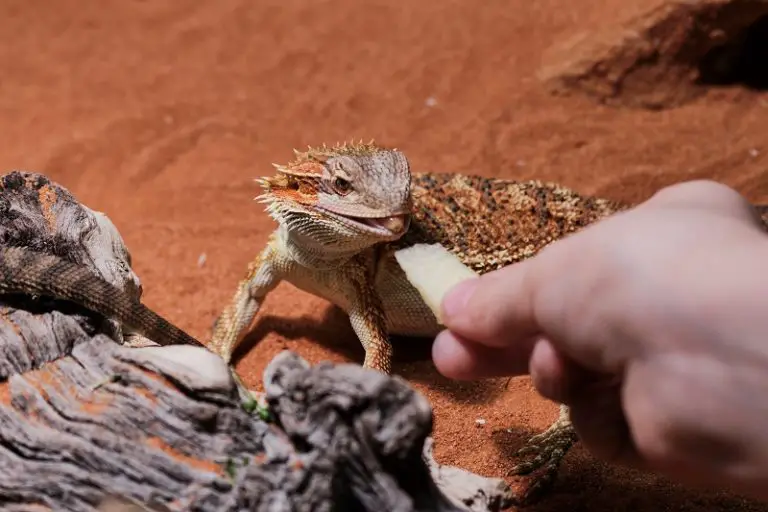
![Best Bedding For Bearded Dragons [Full Guide + Top Options]](https://allourcreatures.com/wp-content/uploads/2021/12/bigstock-Bearded-Agama-latin-Pogona-V-396699188-768x498.jpg)
![Are Bearded Dragons Good Pets For Kids? [Full Guide]](https://allourcreatures.com/wp-content/uploads/2021/11/bearded-dragons-and-kids-768x514.jpg)
